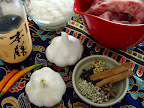Background
Modern Malaysia is a fairly new country, having come into its modern form with the creation of the Federation of Malaysia in 1963, joining with the territorries of Sabah, Sarawak, and the city of Singapore. Singapore left the federation in 1965, so we will get back to them in the future. Malaysia occupies the lower bulge of the Malay peninsula and the northern coast of the island of Borneo. As a result of this distance the two parts of the countries have very distinct histories and culture.
The peninsular part of the country has a long standing history as a trade center. Buminputra is the catch all term for Muslims on the peninsula. The non-Muslim groups are the Chinese, Indian, Portuguese and the indigenous Orang Asli. Islam's influence was brought to the island via Indian traders. Indian communities did not establish large communities until the mid 19th century during British rule. Chinese set up long term trading out posts and began intermarrying in the 15th century. Portuguese settlements were established in the 16th century with rapid intermarriage as well.
The Borneo have a wide diversity of indigenous tribes. The coastal tribes have diets consisting of fish and while the hill tribes tend to subsist on roots and game.
The Lonely Planet Food Guide to Malaysia and Singapore is a concise and excellent resource. Finding information on on breakfast was pretty easy for Malaysia. Nasi lemak consists of steamed rice with coconut mist eaten with anchovies, peanuts, cucumbers, and chili sauce. Idli are black lentil and rice patties. Roti bread served with various topping are also common breakfast dishes. Bak kut teh is a broth made with chopped pork ribs and spices and served with rice. The name translates as pork rib tea and this name along with my general love of pork ribs made me choose this one. A chicken version called chik kuh teh is eaten by the Muslim population.
The tea has many novel spices and roots used in its preparation. White pepper is the exact same seed as black pepper except the pepper fruit's skin is removed before before the drying process. Star anise is the seed of an evergreen tree found in the southwest of China. It gets its name from its close taste to regular anise but the actual plants are very different. Several components of the dish are meant for taste and medicine. Dang Gui (angelica root) is considered the female ginseng and is in the same family as coriander and celery. Yok Chok (Solomon's seal rhizome) is a starchy root. Kei Chee (boxthorne berry) are members of the new world nightshade family. I was only able to locate the Yok Chok in a 2 pound bag so I decided to omit the medicinal herbs from the recipe we made. I include the proportion below if you are able to find and use them.
The chopped pork ribs can be purchased at a Chinese market ready to use. If buying whole ribs make sure you are fully awake before going to work with your cleaver, or chop them up the night before.
Bak Kut Teh
- 1 lb chopped pork ribs, 1 ½ inches in length
- 2 heads of garlic, separated, with the skins intact
- 2 red chillies
- Dark soy sauce
- Salt
- Spice pouch
- 2 cinnamon sticks
- 6 cloves
- 1 tsp black peppercorns
- 1 tsp white peppercorns
- ½ tsp coriander seeds
- ½ tsp fennel seeds
- Herb mixture (optional)
- 5 slices dang gui (angelica root)
- 5 slice yok chok (Solomon's seal rhizome)
- 1 tbsp kei chee (boxthorn berries)

- Put spices and herbs into a muslin pouch or into cheese cloth.
- Place ribs and unpeeled garlic at the bottom of a sauce pan.
- Nest the muslin pouch in the middle of the ribs.
- Add 5 cups of water.
- Bring the water to a boil over medium heat.
- Simmer until the meat is tender. (Our meat took about 45 minutes to be done.)
- Add soy sauce and salt to taste.
- Remove the spice pouch and serve in large bowls with short grain rice on the sides.
- Thinly slice the chilies and place them in a shallow dish. Cover them with a shallow layer of soy sauce and use this for dipping the ribs.
This breakfast was not nearly as complicated as it might appear. Once the ingredients are together you can just let it simmer while you take care of other things.
The broth was very surprising. The first surprise was that it was not completely over powered by garlic. I think keeping the garlic unpeeled kept the flavor from overwhelming the broth. The pepper seeds and spices blend into a nice background. The star anise has a nice licorice flavor that hovers over the rest of the flavors. The pork ribs provide the broth with a rich texture, but it is not too heavy.
The chili soy sauce gave the ribs some heat and a nice flavor, but eating them with chopsticks is a bit of a challenge!

No comments:
Post a Comment